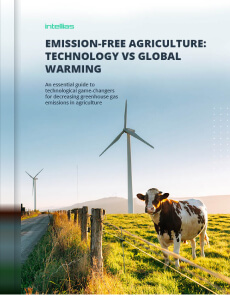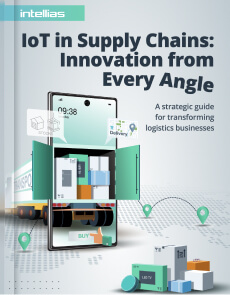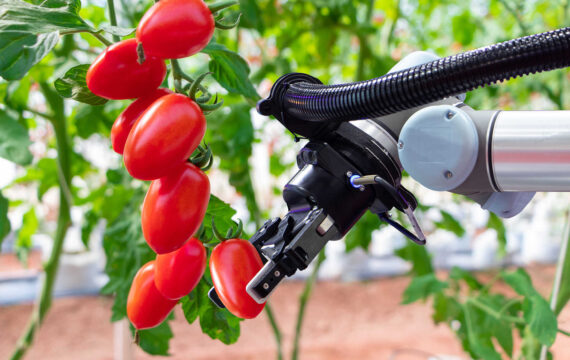Agriculture has never been easy, and it’s only gotten more complicated in recent years. Extreme weather events are more frequent and severe, impacting crop yields. Geopolitical conflict is high, disrupting the movement of goods. And disease outbreaks — both human and animal — are causing labor and product shortages.
What do these things have in common? They’re all agriculture supply chain disrupters that only compound the issues of an already “fiendishly complex” supply chain.
This article will discuss agri-supply chain management. It will cover the basics, challenges, and digital technologies for agriculture that can improve efficiency, profits, and food supply.
What is the agriculture supply chain?
The agriculture supply chain, or value chain as it’s sometimes called, is the process of moving food from farms to consumers through organizations, people, and resources. An interconnected network of businesses — input suppliers, farms, processors, distributors, and retailers — work together to get farm commodities to consumers’ plates.
Challenges in the agri-food supply chain

Agriculture supply chain management is incredibly complex, which affects food quality, safety, sustainability, and economic viability. Specific challenges include:
- Weather dependence — Crop yields and quality depend heavily on weather conditions like rainfall, temperature, etc. This unpredictability makes it harder to align supply and demand.
- Perishability — Many agricultural products are perishable and require quick transport and processing to avoid spoilage. This adds complexity to logistics and inventory management.
- Variability — No two agricultural products are identical in size, taste, etc., which makes standardization and quality control more difficult.
- Labor issues — Agriculture often faces labor shortages from seasonal demand, an aging workforce, and skills gaps as tech rapidly advances.
- Sustainability — Requirements for organic, environmentally friendly, or ethically sourced products add complexity in sourcing, traceability, packaging, transportation, and more.
While these can be major stumbling blocks to efficiency, profit, and customer satisfaction, there are strategies — and technologies — to address them.
Strategies to overcome the complexity of supply chain management in agriculture

To decide which digital and analytics technologies to use, start with your desired outcome.
Understanding your desired future state will allow you to determine the best course of action. It will provide direction and guidance and help you prioritize your tasks and set realistic goals.
For each of the challenges outlined in the previous section, some strategies can help you mitigate the risks.
Weather dependence
The agri-food industry faces a significant challenge due to the inherent unpredictability of weather conditions, which complicates the management of production, inventory, pricing, and other crucial aspects. Some potential strategies include:
- Forecasting demand and optimizing production planning
- Diversifying sourcing across different geographies
- Building flexibility into production plans
- Investing in Controlled Environment Agriculture (CEA) with technologies like greenhouses or indoor vertical farms
Perishability
The perishable nature of items necessitates the implementation of swift and efficient procedures to curtail food loss and minimize waste effectively. Potential strategies include:
- Investing in cold storage and refrigerated transport
- Improving packaging to extend shelf life
- Partnering with local/regional suppliers to shorten transport time
- Using digital tracking and monitoring
Variability
The fluctuation in the biological attributes of agricultural products poses a substantial challenge. A lack of standardization ultimately complicates processing, quality control, packaging, and sales. Specific management strategies include:
- Using manual or automated grading to categorize products based on size, color, ripeness, defects, etc. to segregate by quality
- Using data science to predict ripeness windows and defect rates better and optimize planning
- Using digital sensors, computer vision, and AI for automated quality analysis
- Offering financial discounts to help move products with more variability
Labor issues
Workforce concerns are prevalent in farm labor, which is inherently dependent on manual labor, characterized by seasonality, primarily located in rural areas, and often pays below market rates. This makes recruiting and retaining an adequate workforce an ongoing challenge. To overcome this, farmers should look to strategies like:
- Providing training and education to build skills
- Using digital tools to reduce administrative workload
- Partnering with labor contractors to access seasonal workers
- Fostering an engaging and supportive work culture so employees feel valued
- Reducing labor needs with precision agriculture
Sustainability
Achieving sustainability demands a balance of ecological and societal responsibility alongside financial feasibility, ensuring that the well-being of both the planet and its inhabitants is prioritized while still maintaining economic prosperity and resilience. Potential strategies include:
- Employing circular economy practices to recycle waste and byproducts
- Choosing sustainable modes of transportation and optimizing logistics
- Using sensors and data analytics to optimize fertilizer use
- Incentivizing supply chain partners to use sustainable practices
- Creating transparency in the farming supply chain through traceability tools
What most of these strategies have in common is that digital technologies are the best answer for successful execution.
A day in the life of modern farmer John
Imagine a day at a farm that has already adopted some of these solutions.
It’s 6am when John wakes up. Over breakfast, he checks the AI-generated harvest predictions for his tomato crop. The models predict crop yields using weather, soil, and imagery, making it easier to assign workers and resources for harvesting.
Out in the field, John deploys small robotic ground vehicles equipped with advanced computer vision algorithms. These robots identify ripe tomatoes and gently detach them from the vine, significantly reducing the need for tedious manual labor.
John uses a secure blockchain platform to check certifications for the distribution company that will ship his tomatoes. The ledger’s transparency gives him confidence in the company’s sustainability and cold-chain practices, ensuring that his produce will remain fresh during transit (perishability).
Using his smartphone, John then adjusts the conditions in his smart greenhouse (seasonality, weather dependence). IoT sensors continuously monitor factors like moisture, light, and temperature, allowing John to make precise adjustments that optimize tomato growth.
Later in the day, John reviews data from his automated sorting and grading system. Using near-infrared spectroscopy and machine learning algorithms, the system classifies tomatoes based on ripeness, color, and size. He only ships produce of consistent quality (variability).
John ends his day by examining analytics on the sustainability impacts of his farming techniques. These lifecycle metrics, which include water usage and carbon emissions, help John refine his practices to reduce his environmental footprint.
Blending AI, robotics, blockchain, analytics, and IoT, John improves efficiency, sustainability, and yields on his farm. These tools not only make his life easier but also meet the evolving needs of his customers.
So, exactly what are each of these technologies John is using?
Digital technologies for the agricultural value chain — and how they work together for maximum efficiency

When looking to improve agricultural supply chain management, the first thing that may spring to mind is supply chain software. And that’s certainly one option. But there are many other digital technologies to consider.
Advanced Analytics
Advanced analytics turns massive amounts of agricultural data into actionable intelligence. It includes optimization algorithms and statistical techniques like predictive modeling and simulation that identify data patterns, trends, and correlations. This provides rigorous quantitative analysis to guide data-driven decision-making.
Specifically, advanced data and analytics transform raw sensor readings, equipment metrics, and field imagery into insights that can optimize efficiency, productivity, and sustainability. It enables predictive maintenance to maximize equipment uptime and predictive modeling for data-driven decisions on irrigation, fertilizer, pesticides, and more. Across the supply chain, advanced analytics improve yield forecasting, distribution logistics, inventory management, and waste reduction.
The key focus is applying mathematical and statistical models to derive meaning from agricultural data sets. The quant-driven insights enable precision farming and data-driven decision-making from farm to fork. When combined with AI implementation, advanced analytics unlocks the full value of data for the industry.
Artificial Intelligence (AI)
AI complements advanced analytics by automating data collection and acting on the insights uncovered. Technologies like machine learning, computer vision, generative AI and natural language processing mimic and augment human intelligence. This allows AI in agriculture to take over time-intensive manual tasks.
On the farm, AI-powered drones, sensors, and robots can survey crops, monitor growth metrics, and adjust equipment autonomously. In processing and distribution, AI optimizes operations through pattern recognition, predictive modeling, and adaptive learning. Across the supply chain, AI digitizes and automates data-related tasks to boost productivity.
While advanced analytics focuses on statistical analysis to extract insights, AI uses intelligent automation to operationalize those insights. The combination drives the next generation of data-driven agriculture.
Advanced analytics provides the brains by crunching data into quantitative insights. Machine learning and AI flex the muscle of human-like cognition to apply those insights through perception, reasoning, and informed decision-making. Together, they maximize the value of data to optimize agriculture across the supply chain.
The Internet of Things (IoT)
The Internet of Things (IoT) connects physical assets across the agriculture value chain. Sensors can monitor everything from tractors to livestock to produce while it’s in transit. Networked IoT sensors and edge computing devices generate real-time data to inform intelligent operations and automation.
For example, IoT-enabled soil probes can autonomously trigger irrigation when moisture levels dip. Driverless tractors leverage GPS and AI to optimize planting and harvesting. And RFID temperature sensors detect crop spoilage risk during transport before it happens.
This massive flow of IoT data provides unmatched visibility into conditions across the supply chain. Advanced analytics transforms data into insights and predictive models. AI optimizes operations and emerging capabilities like computer vision quality control. Blockchain builds trust and accountability in IoT data exchange between stakeholders.
The long-term vision for blockchain is fully optimized food production through hyper-connected IoT networks, edge computing, and integrated analytics. As it stands, IoT solutions are enabling the next generation of data-driven agriculture, potentially improving productivity, efficiency, and sustainability outcomes.
Digital Twins
A digital twin is a virtual representation of a physical object or system synchronized through connected IoT sensors. In agriculture, digital twins allow farms to simulate buildings, equipment, livestock, and crops in a digital environment.
For example, farms can model disease spread through a crop using climate and soil data to optimize variables like irrigation and sunlight in preventing outbreaks. Or greenhouses can iteratively adjust conditions to identify ideal grow scenarios. These virtual simulations enable scenario planning and design optimization at lower cost and risk.
The virtual twin stays seamlessly connected to physical assets through two-way data flows. This allows for real-time monitoring and adaptation. As conditions change in the real world, the digital twin can recalibrate itself accordingly.
Farms can link digital twins of tractors, processing centers, and storage facilities to model the entire supply chain. This enables end-to-end optimization and coordination. Integrating the twins with AI and automation creates a self-adjusting system that continuously tunes itself. Digital twins support predictive maintenance of equipment through condition monitoring. They can also train AI systems through robust simulation scenarios before real-world deployment.
By bridging physical and virtual environments, digital twins unlock new opportunities in modeling, prediction, automation, and collaboration across the agriculture lifecycle.
Blockchain
Blockchain provides a decentralized, distributed ledger for transparently recording transactions and data exchanges across the agriculture ecosystem. It establishes trust, accountability, and process integrity through immutable, shared records.
For example, blockchain enables end-to-end traceability in supply chains. Farmers can track the goods’ origin, handling, and transit in real time through shared data on a blockchain. It can also build consumer trust and makes disease outbreaks in crops and livestock easier to isolate.
Smart contracts also automate and validate key transactions like payments and certifications via code rather than intermediaries. For example, a smart contract could automatically verify a certificate was issued and transfer payment upon a shipment’s arrival.
Additionally, blockchain protects data privacy and security for agritech systems. It secures data through cryptography and decentralization, mitigating the risks associated with centralized databases.
Combining blockchain with IoT sensors and AI analytics enhances transparency and trust in data exchange. The sensors and analytics provide validated, trusted data inputs for the blockchain, providing an immutable record of those AI/IoT transactions and data exchanges, so there’s no question of data manipulation later.
How Intellias can help you get started
From farm and livestock management systems to drone imagery analysis to vertical farming, Intellias has years of experience developing ag-tech solutions.
We use our dedicated Digital Lab to develop, validate, and scale agricultural software that lets farmers make data-driven decisions, providing senior engineering teams with expertise in precision farming, GPS, IoT, AI automation, blockchain, cloud computing, and location and mapping services.
Contact Intellias experts today to find out how you can improve the reliability of your supply chain.





